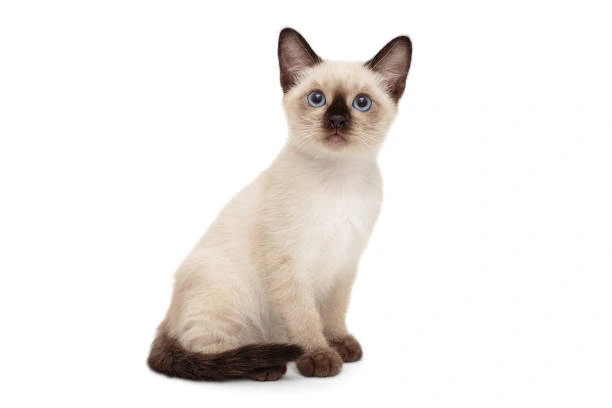Contents
Origin and History
The Siamese cat is one of the oldest and most recognizable cat breeds in the world, with a rich history that traces back to the ancient temples of Siam, now known as Thailand. Revered by royalty and often seen in the royal courts of Siam, these elegant cats were considered sacred and were believed to bring good fortune. The first documented evidence of the Siamese cat dates back to manuscripts from the 14th century, making it one of the oldest natural breeds. Siamese cats were so valued that they were rarely allowed to leave their homeland, which is why it wasn’t until the late 19th century that they made their way to the West. The breed first appeared in England in 1871 at the Crystal Palace Cat Show and quickly captured the fascination of cat lovers with their striking appearance and distinctive personalities. By the early 20th century, Siamese cats had established themselves as a popular breed in Europe and North America, and their popularity has only grown since.

Physical Appearance
The Siamese cat is known for its sleek, elegant appearance and its unique color-pointed coat, which sets it apart from other breeds. Their body is slender, long, and muscular, with a fine-boned, graceful structure that gives them an athletic yet refined look. Their most notable feature is their stunning almond-shaped blue eyes, which are deep and expressive, often conveying an air of intelligence and curiosity. The Siamese coat is short, fine, and glossy, lying close to the body, which accentuates their graceful form. The breed’s color points—ears, face, paws, and tail—are darker than the rest of the body and come in various shades, including seal, blue, chocolate, and lilac. This distinctive color pattern results from a temperature-sensitive enzyme that causes the cooler parts of the body to develop a darker color, while the warmer central parts remain lighter. Siamese cats also have large, pointed ears that are set high on the head, adding to their alert and curious expression.

Personality and Temperament
Siamese cats are renowned for their unique personalities, which are as striking as their appearance. They are highly intelligent, social, and interactive, often forming strong bonds with their human companions. Siamese cats are known to be very vocal, using a distinctive, low-pitched “meezer” voice to communicate their needs, desires, and opinions. They are often described as extroverted and can be quite talkative, engaging in what some owners fondly refer to as “conversations.” This breed thrives on interaction and affection and may become lonely or bored if left alone for long periods. Siamese cats are playful, energetic, and curious, often getting into everything from cupboards to closets, making them a constant source of entertainment. They are quick learners and can be taught tricks, fetch, or even walk on a leash, reflecting their sharp intelligence and love for mental stimulation. Despite their independent streak, Siamese cats are also known for their loving and affectionate nature, often following their owners from room to room and curling up on laps to show their devotion.
Health and Care Needs
Caring for a Siamese cat involves a blend of attention, affection, and maintenance tailored to their specific needs. Their short coats are relatively low maintenance compared to long-haired breeds, requiring minimal grooming—usually just a weekly brush to remove loose hair and keep their coat looking sleek and shiny. However, Siamese cats are prone to certain health issues, including dental disease, respiratory problems, and, in some cases, heart conditions such as hypertrophic cardiomyopathy. Regular veterinary check-ups, a balanced diet, and good dental hygiene are essential to their overall health. Siamese cats also have a reputation for being a bit more sensitive to anesthesia and certain medications, so it is important to work with a vet familiar with the breed’s specific needs. Additionally, their active and intelligent nature means they require plenty of stimulation to prevent boredom, which can lead to behavioral issues. Providing a variety of toys, scratching posts, and interactive play sessions will help keep them mentally and physically engaged.
Social and Environmental Needs
Siamese cats thrive in environments where they are a central part of the family dynamic. They are not well-suited to households where they will be left alone for extended periods, as they are prone to separation anxiety. Siamese cats are happiest when they have regular human interaction and companionship. They are excellent for families with children, other pets, or anyone looking for a deeply engaging, loyal companion. Because they are naturally curious and playful, they enjoy exploring their surroundings and need a stimulating environment that includes plenty of playtime, vertical spaces like cat trees, and hiding spots for exploration. These cats are known for their adaptability, but they appreciate a stable environment where they can develop routines and feel secure. Given their social nature, Siamese cats often do well in pairs or with other pets to keep them company.

Conclusion
In summary, the Siamese cat is a unique and engaging breed that offers a delightful combination of intelligence, beauty, and affection. With their striking looks, expressive blue eyes, and distinctive voice, they are hard to ignore and even harder not to love. While they require a bit of extra attention and care to meet their social and emotional needs, the rewards are well worth the effort. A Siamese cat can bring joy, laughter, and a special kind of companionship to any home, making them an excellent choice for those who appreciate a cat with a personality as bold and beautiful as their appearance.

